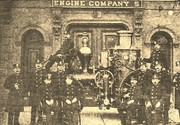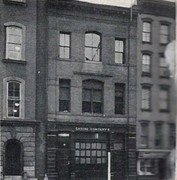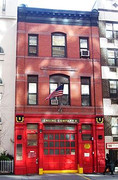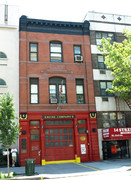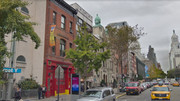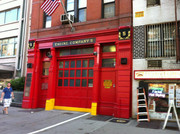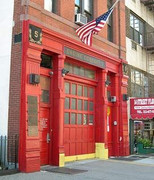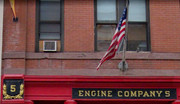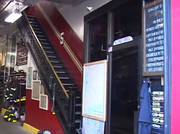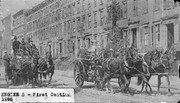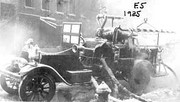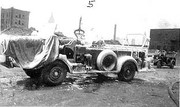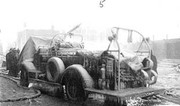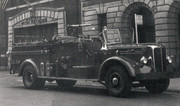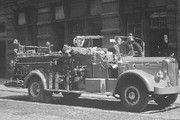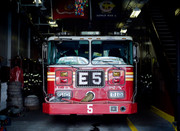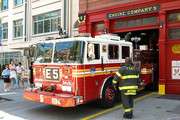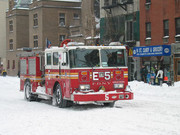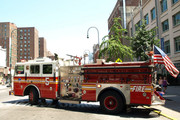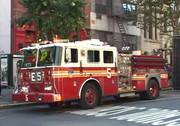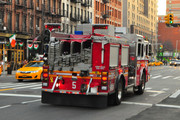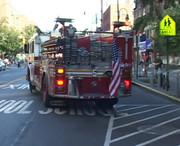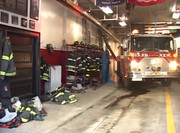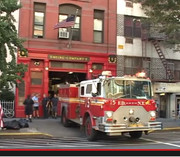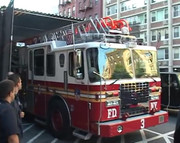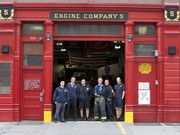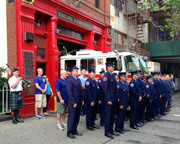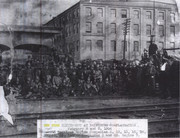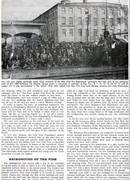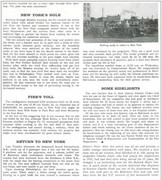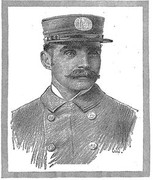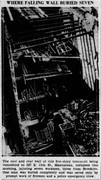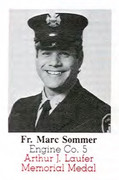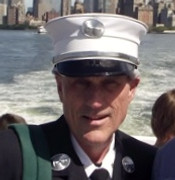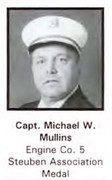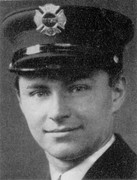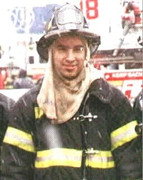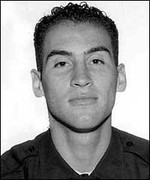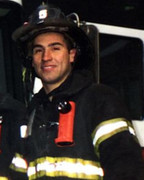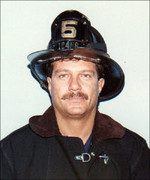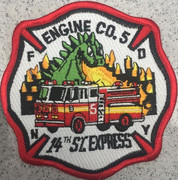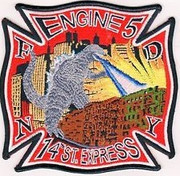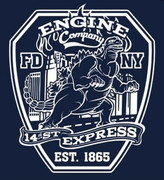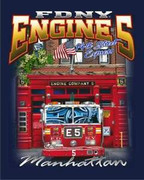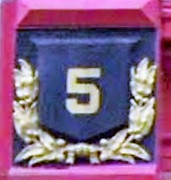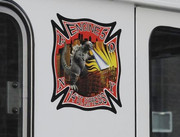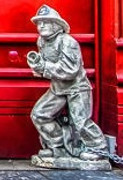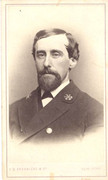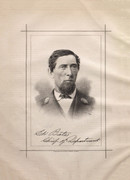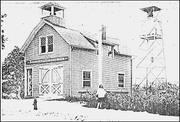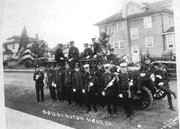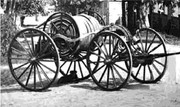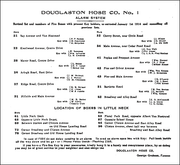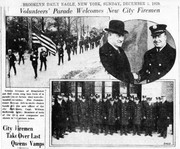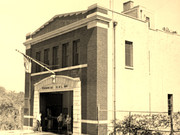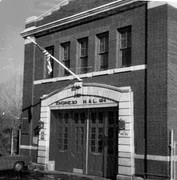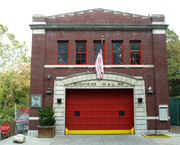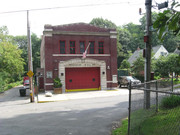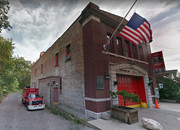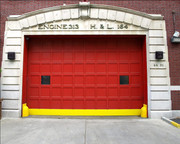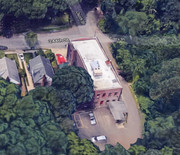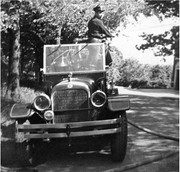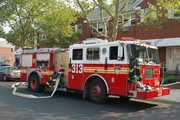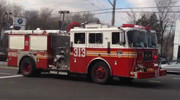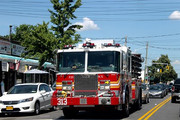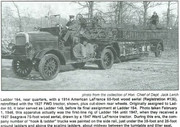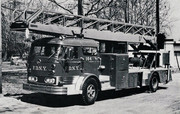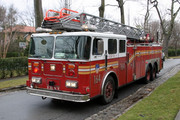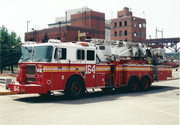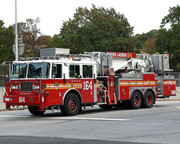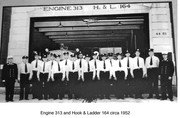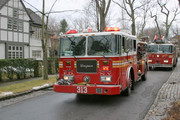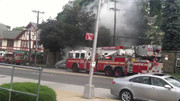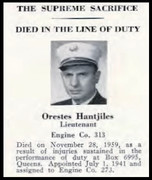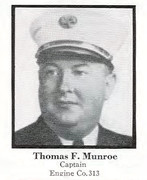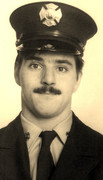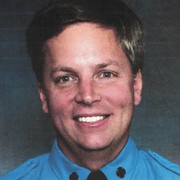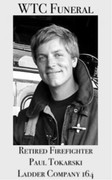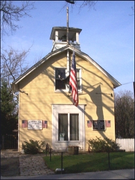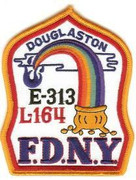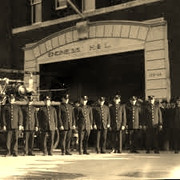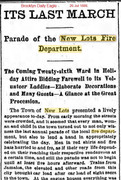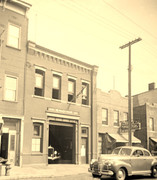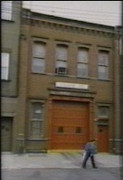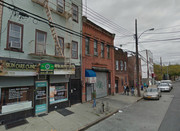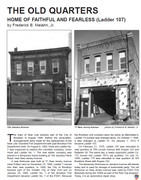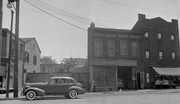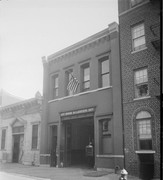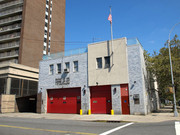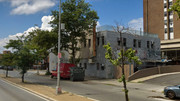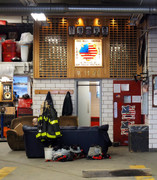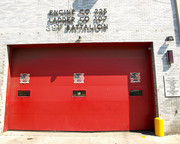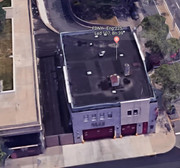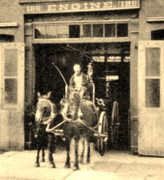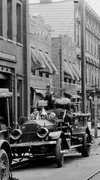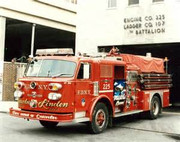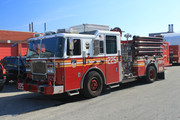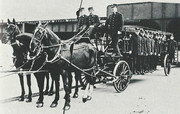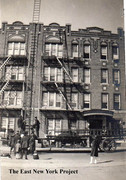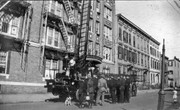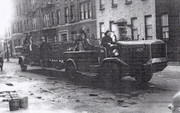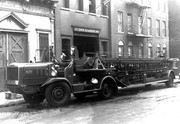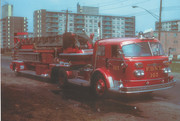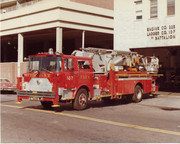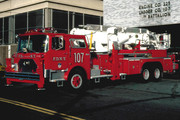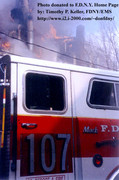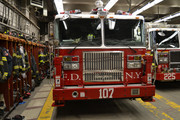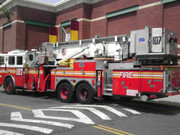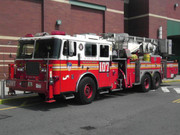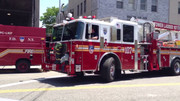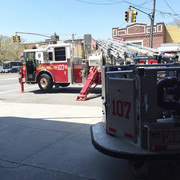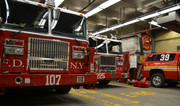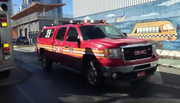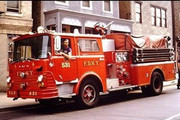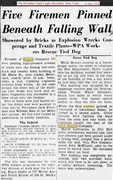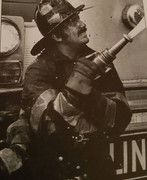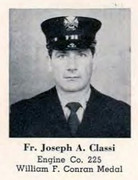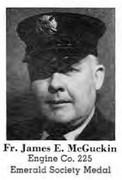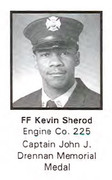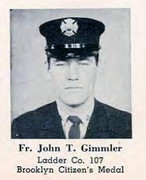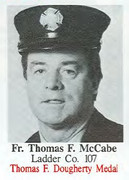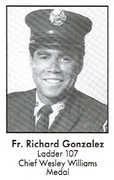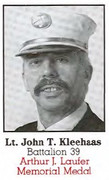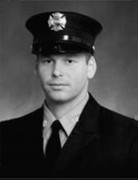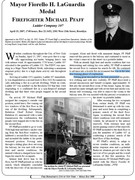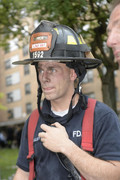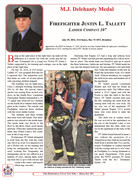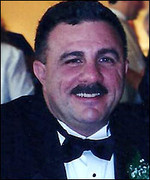Engine 225/Ladder 107/Battalion 39 (continued)
Brooklyn Fire Department:
ENGINE COMPANY No. 25: PROTECTOR OF NEW LOTS
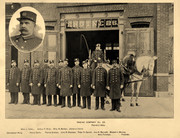
ENGINE COMPANY NO. 25. When the law annexing the town of New Lots to Brooklyn went into effect on Aug. 4, 1886, the old Volunteer Department of that town disbanded and the city authorities took immediate steps to afford the residents of that new ward the protection against fire guaranteed them by the provisions of the annexation act. Accordingly on the night of Aug. 3, an engine company and a truck company were organized and installed in the annexed district ready to do service as soon as the midnight hour arrived. The tolling of bells, the shrieking of whistles and other noisy demonstrations, announced to the towns-people that New Lots only lived in history and that henceforth the territory was a part of Brooklyn. Engine Company No. 25 was accordingly born with the ward. Thirteen men under the command of Foreman Michael J. MURRAY made up the company. A two-story frame building on Liberty Avenue, near Vermont Avenue, had been fixed up as a temporary home for the men, and everything started under the most favorable auspices. For some time the company had no engine, the tender doing all the duty necessary. As the flow of water in every part of the ward is great the lack of an engine was not felt. In the meantime a site for a new engine- house was selected on Liberty Avenue near Cleveland Street, and work on the present structure was begun.
A fine double-cylinder engine of the Clapp & Jones pattern was ordered for the company's use. On June 10, 1890, the house was in readiness and the formal transfer was made. The men were pleased to get into the new quarters and the occasion was one participated in by many prominent city and fire officials and citizens of the Twenty-sixth Ward. The present house was built expressly for Fire Department uses, and it is needless to say has all the latest appliances and improvements known to facilitate the work which above all others must be done promptly. It is of brick, two stories in height, with brownstone trimmings, 25 x 100 feet. The interior is finished in yellow pine, with racks, lockers and other necessary requisites for the men, horses and apparatus.
The district covered by the company is a large one and includes all the Twenty-sixth Ward. It is bounded by the Queens County line on the east and north, by the town of Flatlands on the south, and by Rockaway Avenue oh the west. It covers an area of seven and three quarters square miles, and while essentially a residential district, it has several large manufactories and institutions within its confines. The houses are mostly of wood. There is perhaps no section of the entire city growing as rapidly as the Twenty-sixth Ward. During the year 1891, permits for the erection of upwards of 500 buildings were issued. At the present time the company responds to thirty-two first-alarms and twelve second-alarm calls. In 1891 the company attended between forty and fifty fires, but none of them, thanks to the efficiency of the company, made much headway. Among the large structures in the district is the House of the Good Shepherd, taking up the entire block bounded by Atlantic Avenue, Pacific Street and Rockaway Avenue, with its nearly 2000 inmates; the Truant Home and St. Malachi's Orphan Asylum. The manufactories include Clever & Nelson's torpedo works, Davis' starch works and other large concerns. The district is the terminal point for three lines of elevated railways, where hundreds of cars and locomotives are housed. In addition to these Atlantic and Fulton Avenues are lined with large buildings used for mercantile purposes.
Four of the fleetest and best-trained horses in the Department belong to the company. Excellent time is made hitching up and not a second is lost in getting to a fire. The personnel of the company is equal to any other in the entire Department. At present there are thirteen men on the roster. Up to the present time Engine Company No. 25 has a "clean sheet" on the records at Headquarters, and from the willing way in which the men perform their duties and the family-like feeling that pervades the house it will be a long time before this meritorious record is broken. The men are all ambitious, devoted to the business, and have a full knowledge of what is expected of them. They go about their work coolly and intelligently, and in the parlance of the day,"get there every time."
Foreman MICHAEL J. MURRAY is an old-time fire laddie. He was born in Ireland on Nov. 1, 1847, but arrived in this country before he was able to tell his name. Before the Paid Department was organized he was a member of old Volunteer Hook and Ladder Company No. 4. On Washington's birthday, 1872, he was made a member of the Paid Department, and assigned to Engine No. 1, where he remained for nine years. From there he was transferred to Truck No. 1, where he spent a short time. He was then sent to Engine No. 19 and continued a member of that company for six years. When Engine Company No. 25 was organized, he was appointed Foreman. His record as a fireman is good. During his twenty years' service he has taken part in all the big fires. He has assisted in the rescue of several lives, notable among them being the removal of a woman from the third story of a burning building in Sheffield Avenue, near Glenmore Avenue, on April 13, 1888. For this brave act he was complimented by his superior officers. He was also commended for his action in extricating a woman from the ruins of a building that collapsed in the Twenty-sixth Ward, on May 10, 1890. Foreman MURRAY served in the navy during the war and is a member of the Grand Army of the Republic.
Assistant Foreman JOSEPH H. BENNETT enjoys the distinction of being the first man appointed in the Paid Department. Six days before the Department was in running order he was delegated to look after the horses that were to be used, and on the 15th day of September, 1869, was assigned as driver to Engine No. 10. He served with that company for nearly twenty years, the only interruption being a short time he did service with Engine No. 22, to which he was transferred by Commissioner POILLON. He then returned to Engine No. 10, where, he remained until he was made an Assistant Foreman on July 1, 1889, and sent to his present place. Like Foreman MURRAY, "old man BENNETT," as he is familiarly called, served in the navy during the war, and not only has a good fire record but a good war record. He has been at nearly all the big fires and has had several narrow escapes from death. At a fire in Moore's stable on Pennsylvania Avenue, he was overcome by the heat. but his wonderful vitality enabled him to recover in a few minutes. On another occasion he fell from a ladder a distance of twenty feet, and his associates thought he was dead. The only injury he received was a sprained nkle which kept him indoors only for a week. Mr. BENNETT was born in New York City on May 11,1842, and though 50 years of age is as sprightly as the youngest man in the company.
PATRICK J. KELLY, the driver, although a member of the Department only since September 1, 1887, is an old fireman. He served in the New Lots Fire Department before the town was annexed, being a member of Independent Pump and Bucket Company. He was promoted to Assistant Foreman and later to Foreman, and at the time when the New Lots Department disbanded, had been raised to the responsible position of Assistant Chief Engineer. Since his connection with the Paid Department he has served for a short time with Truck No. 7, and was then transferred to Engine No. 25. He was born in Brooklyn in 1862, and before becoming a fireman was engaged in the furniture business.
Engineer PETER H. CARROLL has a record that any man might feel proud of. He was born in New York on May 27, 1845, but became a resident of Brooklyn at an early age. During the days of the Volunteer Department he ran "widder masheen" and was a member of Hook and Ladder Company No. 2, of the Eastern District. On April 9. 1872, he was appointed a fireman, and has done duty respectively with Truck No. 5, Engines Nos. 15 and 16 and has been with Engine No. 25 since February 10 1891. He won much praise for the daring rescue of two children from a burning house on Ainslie Street, near Union Avenue.
WILLIAM H. BERDAN was born on Feb. 20, 1849, at Paterson, N. J. He was appointed a fireman Dec. 9, 1878, and has a good record. For two years he was a member of Truck No. 7, and for six years of Engine No. 10. When Engine No. 25 was organized, he was sent there and has been a member ever since.
JOHN R. BRAISTED was born in Brooklyn, June 20, 1852. On Dec. 15, 1885, he was appointed a fireman and assigned to Engine No. 22. He served there for only four months, when he was transferred to Engine No. 14. From there he went to Engine No. 25, and for four years he has served faithfully. Before becoming a fire laddie he was an agent and collector, and possesses all the
wit and snap characteristic of men in that business.
CHRISTOPHER MANG has been a member of the Department since Feb. 1, 1887. He was born in this city on Feb. 27, 1858, and with the exception of one month's service as a member of Engine No. 19, he has spent his entire time with Engine No. 25.
PATRICK J. GRAHAM has been a fireman since Dec. 2, 1887. He was born in Ireland on March 25, 1860, but has spent a quarter of a century of his life in this city. He was a member of Truck No. 7 for three years and was then transferred to Engine No. 25. His record is good. At a fire in the Twenty-sixth Ward two years ago he fell from a ladder a distance of 27 feet and escaped uninjured.
HENRY CARLIN was born in Ireland on Sept. 14, 1854, but came to this country at an early age. His family located in Brooklyn, where Henry has spent an active life. On July 15, 1889, he was appointed a fireman and assigned to Engine No. 25, where he has served since. On Feb. 10, 1891, he was made stoker. He is popular with his associates, and enjoys the confidence of his superior officers.
WILLIAM J. CALLAN was born on May 4, 1867, in this city. On Oct. 15, 1800, he donned a fireman's uniform, which he has worn with credit to himself and the Department. He is a quiet, unassuming young man who promises to make his mark.
JAMES J. COZINE was born in this city on Jan. 18. 1869, and was appointed a fire- man on March 12, 1891. Although only a short time in the business he has demonstrated that he is made of the material so much desired in a fireman.
ARTHUR T. ROBB was appointed on Nov. 16, 1891. A perfect athlete in build and cool as the proverbial cucumber, he possesses all the requisites of a good fireman. He was born in this city and before being a fireman was a car conductor. (from "Our Firemen - Official History of the BFD")
HOOK AND LADDER COMPANY NO. 7: THE FIRST IN THE ANNEXED DISTRICT
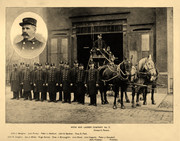
Truck No. 7 is located on New Jersey Avenue, between Fulton Avenue and the Jamaica Plank Road. It was organized on Aug. 4, 1886, the day the town of New Lots was made a part of Brooklyn. The first home of the company was in a little two-story frame building on the Jamaica Plank Road near New Jersey Avenue, which was fitted up for temporary quarters. For nearly three years the company remained there, until the present fine structure was built and ready for occupancy.
On the night before the law annexing New Lots to the city of Brooklyn went into effect, twelve tried and true men were delegated to go out to East New York and do service with the new truck company. Captain Peter Campbell, for many years in charge of Truck No. 3, was placed in command, and as he has often said since, he was surrounded by a force of men that seldom had an
equal and never a superior in the Department. The hour of midnight announced to the men that their duty had begun. Provided with a new and perfectly equipped Hayes Truck and a spanking trio of horses, the men started out under the most favorable auspices. How well the trust reposed in them has been discharged is. best attested by the esteem in which the men are held by the residents and tax-payers. There was of course some opposition to the Paid Department in the new ward, but it only came from the members of the Volunteer Fire Department. For a long time the latter had performed all the fire duty in the town and looked upon the work and attendant honor as theirs by right. But it did not take the residents and tax-payers long to appreciate the change for the better, and while they felt grateful to the volunteers for what they had done the introduction of the Paid Department of Brooklyn was hailed as a great boon, the effect of which has been felt since in the large number of houses that have been erected.
The territory covered by the company is a large, growing and important one. It includes all the Twenty-sixth Ward and the upper end of the Eighteenth Ward. The company responds to thirty-six first-alarm calls and to twenty on the second-alarm. Last year the company attended over 100 fires, the largest of which was in the dry goods and furnishers' house of Bourke & Ryan and the adjoining houses, with a loss of about $100.000. Truck No. 7 was the first company at the scene, and owing to the hard and intelligent work performed by the men the fire was limited in its extent. Among the large and important structures in the ward are the car houses and terminal stations of. the Kings County and Brooklyn Elevated Railway Companies, the car houses and freight depot of the Long Island Railroad Company, the Long Island Water Supply Company's plant, the House of the Good Shepherd, St. Malachi's House, and several large manufacturing concerns.
The men of the company are well drilled and disciplined. Excellent time is made in hitching up and getting out to a fire. On several tests the "turn was done" in twelve seconds, although the horses necessarily have far to go on account of the length of the truck. Among the members of the company are many veterans in the business, together with a sprinkling of young men of brawn
and muscle.
Foreman PETER CAMPBELL is one of the best-known men in the Department. He was born in New Orleans, La., on March 10, 1844. His parents, four years later, removed to this city. Peter attended the public and parochial schools of the Second Ward and at an early age was apprenticed to the hat trade. When old enough he joined the Volunteer Fire Department, becoming a member of old Engine No. 4 then located on High Street, where Engine No. 6 now lies. Later he served with Constitution Engine No. 6, stationed in Bridge Street. When the Paid Department was organized in 1869, he was one of the first men appointed and was assigned to Truck No. 3, on Concord Street. In 1883, when the civil service law went into effect, he was one of the first applicants to enter the examination for appointment as a Foreman. Out of a class of nearly thirty, he stood first in the list and was appointed on March 20, 1883. He was sent to command Engine No. 9, but only remained there a few months, when he was returned to Truck No. 3, to take charge of it. When the town of New Lots was annexed to Brooklyn, Commissioner ENNIS selected Foreman CAMPBELL to organize Truck No. 7, with which he has since remained. Since his residence in the Twenty-sixth Ward he has earned the respect of his neighbors and the business community. He is cool and self-possessed in time of fire and has frequently distinguished himself in the rescue of people from burning buildings. At a fire in Mr. Campbell's bakery at No. 75 Main. Street, in 1881, he rescued a three years' old boy from the third story. He then returned to the burning building and took a woman and child out by way of adjoining roofs. On Jan. 12, 1880, he heard the cry of fire from a stable at the comer of Gold and Concord Streets. Responding to the call he found Mrs. Bridget KELLY enveloped in flames. He instantly divested himself of his overcoat and threw it around her. She was taken to the Long Island College Hospital, but she died a week later. Another occasion, when he took great chances with his own life. was in the rescue of Thomas COMESKY, whom he carried from a burning building on Poplar Street near Henry Street, April 2, 1882. The fire broke out about midnight, but before Mrs. COMESKY, the mother of the boy, could be got out, she was burned to death. For gallant service rendered at a fire in Silas Ilsen's tin factory at York and Adams Streets, in 1884, Foreman Campbell was personally complimented by Commissioner Partridge and the owner, and was made the recipient of an engrossed resolution reciting his gallant deed.
Assistant Foreman JOHN HOGARTH is an old fireman, although he has been in the present Department only since Feb. 16, 1887. He was born Nov. 26, 1852, in New York City, but went to live in the town of New Lots when a boy. He joined the Volunteer Fire Department of that town and was raised from a fireman to be the Chief Engineer of the Department, filling that important position when the town was annexed to Brooklyn. It will be seen therefore that he brought a ripe experience to his duties in the Paid Department and a thorough familiarity with the district in which he now serves. He first did duty in Engine No. 25; from there he was sent to Truck No. 7, where he has served since.
JOHN DOWD is an old and faithful fireman. He was born in Ireland on Feb. 12, 1848, but has long been a resident of this city. On Dec. 15, 1872, he was appointed a fireman. He has been at all the large fires and has met with several accidents while in the discharge of his duty. He was first assigned to Truck No. 2. Then he went to Engine No. 10, where he spent sixteen years. He served for a short time in Engines Nos. 17 and 2, in the order named, and when New Lots was annexed he was transferred to Truck No. 7, as an original member, and has continued to serve there.
JOHN A. LANGDON has been in the Department since Jan. 28, 1882, and in the days of the Volunteer Department he ran with Hose No. 6, of the Eastern District for ten years. He was born in New York City, March 23, 1838, but removed to this city before he attained his majority. During the war he was a mechanic in the Navy Yard. He has done duty in the following companies: three years in Engine No. 22, three years in Engine No. 16, and the rest of the time in his present place. He is a good fireman, well spoken of by his superiors and justly popular with his associates.
JAMES S. GARDNER was born in Meriden, Conn., Oct. 18, 1854. On Dec. 15, 1885, he was appointed a fireman and sent to Engine No. 6. He served eight months there and was then transferred to Truck No. 7, where he has been since. He is a man of fine build, as brave as a lion and well adapted to the calling he has chosen.
HORACE C. PENSON, the driver of the truck, was born in Baltimore. Md., in 1846. When the war broke out, although not of age, he joined a Maryland regiment of infantry and went to the front. When hostilities closed he came to this city. On July 1, 1885, he was appointed a fireman and assigned to Engine No. 18. He remained there for a year, and when Truck No. 7 was organized, was transferred to it. He is a skillful driver, devotedly attached to his horses, and takes pride in keeping them in a spick and span condition.
JAMES J. MILLER is a thorough Brooklynite. He was born here and has always lived here, and says he will die here. He was born in 1864 and was appointed a fireman on Sept. 21, 1887. Since his connection with the Department he has served respectively as a member of Engine No. 19, Truck No. 5 and Truck No. 7. Before being a fireman he was engaged in the milk
business.
JOHN PORTER, the oldest member of the company in years, has been a member of the Department since March, 1888. He has a good war record as well as a good fire record. He was born in London, England, in 1845, but came to this country when a boy. During the war he served with the 7th Reg't. Maine Vols., and later with the 7th U. S. Cavalry. For eleven months he was a private, but for bravery he was promoted to be a sergeant. He enlisted at the age of seventeen years and was present at many important engagements and was slightly injured at Cedar Creek. At the close of the war he returned to New York, and finally located in this city, where he became well known as a horseman. He has served as a member of Trucks Nos. 3 and 5, and from the latter he was transferred to Truck No. 7.
PETER J. HADDOCK was invested with a badge and uniform on Oct. 14, 1890, and possesses all the requisites of a good fireman. Cool, alert, and ambitious, he promises to make his mark in fire annals. He was born in Liberty, Sullivan County, N. Y., on July 29, 1865. He has only served with Truck No. 7.
HUGH GARRAH, one of the youngest and best men in the company, was born Aug. 1, 1866, in Ireland, and possesses all the agility and wit of the race. He settled with his parents in this city, and on Feb. 1, 1891, was appointed a fireman by Commissioner Ennis. He was assigned to Truck No. 7, where he has served since.
JOHN J. MEAGHER, another of the young men, was born in this city, Sept. 19, 1865, and was appointed a fireman March 23, 1891. Although a comparative novice, he can tell some of his older associates something about fire duty. Since his appointment he has been a member of Truck No. 7. Prior to his appointment he was a plumber.
CHARLES E. FIELD is the youngest member of the company in years and service. He was born in New York City. March 28, 1869, but since his boyhood days he has been a resident of this city. On July 17, 1891, when he was only twenty-two years of age, Commissioner Ennis appointed him from a high place on a large eligible list. (from "Our Firemen - Official History of the BFD")
